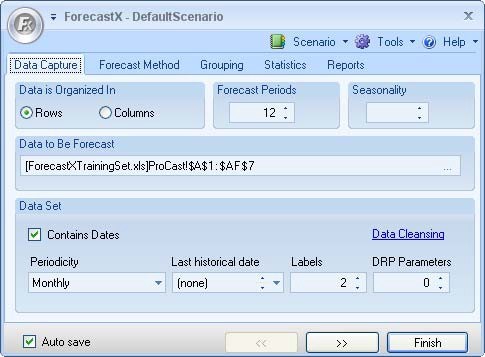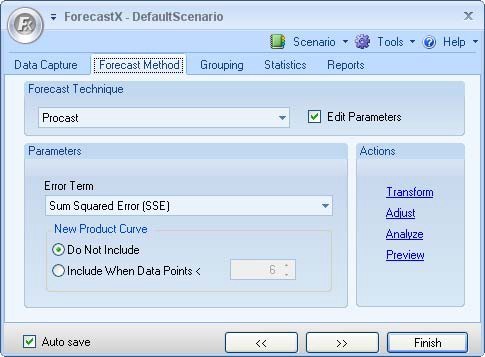Procast™ is ForecastX's™ one-step forecast with expert selection. Procast chooses from complex forecasting techniques, including most time series forecasting methods, new product growth curves, and Regression models to produce fast, accurate, and easy to read results.
You can run Procast on a single data series or create an unlimited batch forecast. Once Procast has been activated, ForecastX determines the best forecasting technique for each data series in your particular data set.
To open the Procast forecasting technique:
- Click on
 and open the ForecastXTrainingSet.xls file.
and open the ForecastXTrainingSet.xls file. - Click the Procast tab at the bottom of the Excel sheet to select the example spreadsheet.
- Click in a cell containing data and open the ForecastX by clicking on
 . ForecastX displays.
. ForecastX displays.
- Click on the Forecast Method tab. By default, the Procast Forecasting technique displays.

- Select Edit parameters to activate Procast’s parameters.
The following table details what each parameter means.
Parameter Description Error Term The measurement Procast uses to determine which forecasting method is optimal. The best method produces the smallest value of the designated statistics. New Product Curve There are two options for the New Product Curve parameter:
- Do Not Include — Select this option to remove the New Product Curve as one of the forecast methods options.
- Include when num of obs — Select this to include New Product Curve as a forecasting method, if the number of observations in the series is less than the number you specify.
- Click Finish. The Forecast Results window displays. The Forecast Result window enables you to view certain information about the generated report such as the number of items that were processed for the report.
- To accept the Forecast, click the View Output button.
- To rerun the Forecast, return to the original workbook and click the Reforecast button. The Data Capture tab displays to allow you to select other forecasting techniques.
A Standard Report is generated on a separate spreadsheet. The new report lists the forecasting method used for each data series. The fitted and forecasted values are listed below the actual values for each series.
Scroll to the right of the spreadsheet to see the forecasted values listed in bold. To the right of the forecasted values, ForecastX produces four accuracy statistics that help you determine the accuracy of the forecast.
The following table details what each statistic means:
| Statistic | Description |
| Mean Absolute Percentage Error |
The overall average of the error measurements Percentage Error ForecastX produced. |
| R-Square | Determines how well the fitted values compare to the actual values. |
| Mean | The average value of each series. |
|
Standard Deviation |
The measure of how widely the values in a group of data spread. It is defined as the square root of the variance. |